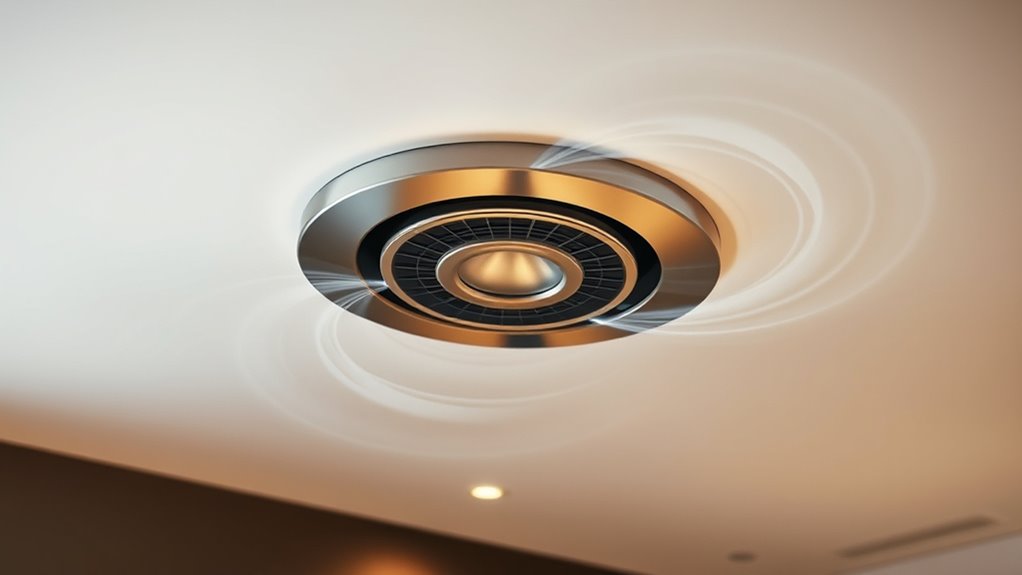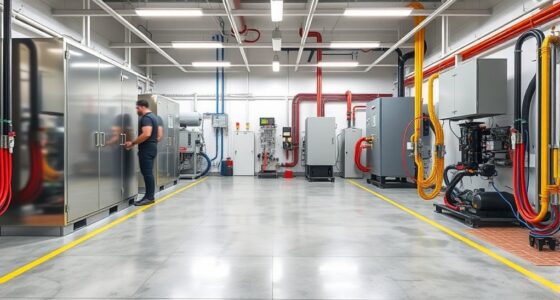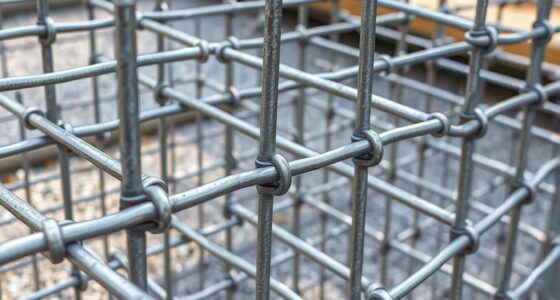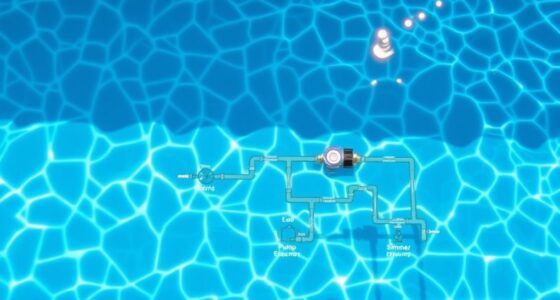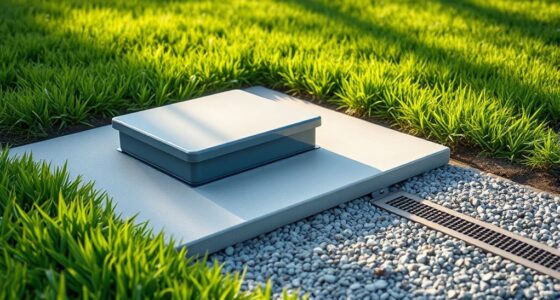To eliminate dead zones with smart circulation, focus on properly placing return jets near stagnant areas and obstacles. Position them at a height and angle that promote gentle airflow, and use multiple jets for balanced distribution. Avoid obstructing vents or placing jets in corners. By evaluating your space’s layout and airflow patterns carefully, you can markedly improve comfort and air quality. Keep exploring for tips on optimizing your return jet setup and maintaining effective circulation.
Key Takeaways
- Strategically place return jets near dead zones and turbulence-prone areas to improve airflow and eliminate stagnant air pockets.
- Position return jets at appropriate heights and angles to promote gentle, sweeping airflow and prevent drafts.
- Use multiple return jets to create balanced circulation and ensure even temperature distribution throughout the space.
- Regularly assess airflow patterns and adjust jet placement based on room layout and furniture to optimize circulation.
- Avoid obstructions and ensure proper vent placement to maximize the effectiveness of return jets in reducing dead zones.
Understanding Dead Zones and Their Impact on Comfort
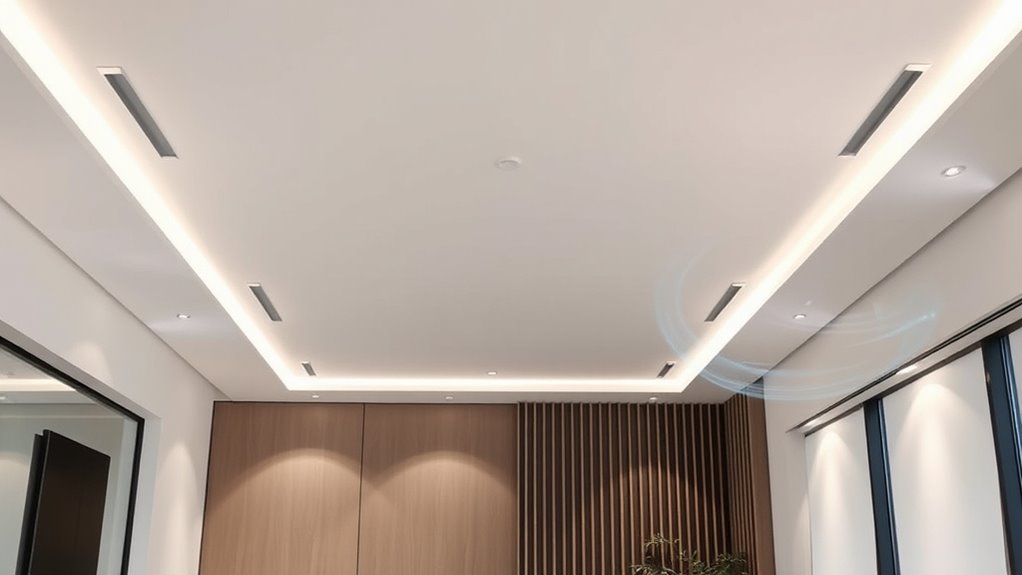
Have you ever noticed how certain areas in a jet’s interior feel less comfortable than others? These are often dead zones, spots with poor air circulation where fresh air doesn’t reach effectively. When air isn’t properly circulated, these areas can become stuffy, warm, or humid, making your overall experience less pleasant. Dead zones may cause discomfort, especially during long flights, because stagnant air can lead to uneven temperature distribution and reduced air quality. Recognizing these areas is essential for improving cabin comfort. Proper placement of return jets helps eliminate these dead zones, ensuring that air flows evenly throughout the cabin. Effective circulation is crucial for maintaining a comfortable environment, and when circulation is optimized, everyone feels fresher, more comfortable, and better rested at the end of the journey.
The Role of Return Jets in Air Circulation

Return jets play a vital role in improving airflow dynamics in your space. By strategically placing them, you can reduce dead zones and guarantee even temperature distribution. Proper vent placement with return jets helps optimize overall air circulation, making your environment more comfortable. Incorporating proper airflow management techniques ensures a more efficient and balanced heating or cooling system.
Enhancing Airflow Dynamics
To optimize airflow within a space, strategically placed return jets play a crucial role by directing air efficiently and maintaining consistent circulation. They help create a balanced environment by preventing stagnant air pockets and ensuring fresh air reaches all areas. Proper placement of these jets influences airflow patterns, reducing turbulence and uneven distribution. When return jets are positioned thoughtfully, they work with supply vents to promote smooth, even circulation. This coordination improves the overall airflow efficiency, preventing energy waste. This enhances comfort and air quality, especially in complex or large spaces. Additionally, well-placed return jets minimize drafts and temperature inconsistencies, making the environment more comfortable. By focusing on airflow dynamics, you can considerably improve overall ventilation, making your space feel more uniform, fresh, and energy-efficient.
Reducing Dead Zones
Strategic placement of return jets is key to minimizing dead zones—areas where air circulation is weak or stagnant. When you position return jets properly, you create a more even airflow throughout the space. This helps improve indoor air quality by ensuring fresh air reaches every corner. By directing return jets toward low-flow areas, you encourage air to circulate more efficiently, reducing temperature disparities and enhancing overall ventilation effectiveness. Proper placement also helps eliminate hot or cold spots, making your environment more comfortable. You should evaluate your space carefully, identifying areas with poor airflow. Adjusting return jet locations accordingly ensures that circulation is thorough, and dead zones are minimized. This simple step greatly enhances overall ventilation effectiveness.
Optimizing Vent Placement
Optimizing vent placement is essential for maximizing air circulation and ensuring a comfortable indoor environment. Properly positioned vents help direct airflow where it’s needed most, preventing stagnant areas. Start by placing supply vents near the ceiling or high on walls to promote even distribution. Avoid blocking vents with furniture or curtains, as this restricts airflow. Use return jets strategically to draw stale air back efficiently, creating a balanced cycle. Consider the room’s layout and high-traffic zones to determine the best locations. Regularly adjusting vent positions based on room use and airflow patterns can considerably improve comfort and air quality. Proper vent placement is key to smarter, more effective circulation. Additionally, understanding the role of return jets in air circulation can further enhance your system’s efficiency.
Principles of Effective Return Jet Placement
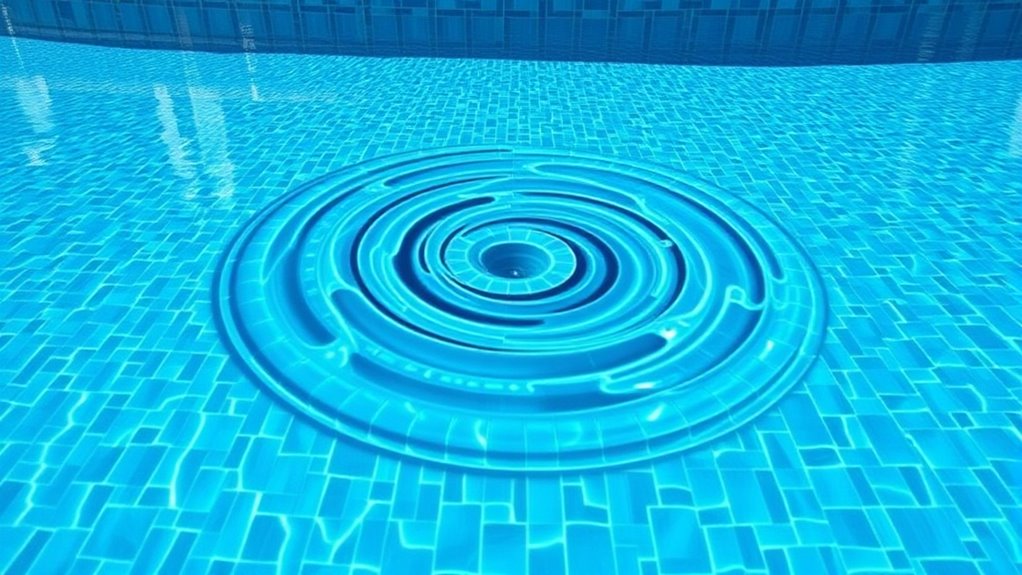
Effective return jet placement hinges on understanding how to direct airflow to optimize aircraft performance during descent and landing. You want to position the jets where they can create a smooth, consistent airflow pattern that guides incoming air efficiently. Place return jets near areas prone to turbulence or dead zones, ensuring they help circulate air evenly throughout the space. The jets should be angled to promote a gentle, sweeping flow rather than disruptive gusts. Balance is key—too many jets or incorrect placement can cause turbulence, while strategic positioning enhances airflow and stability. Focus on creating a cohesive circulation pattern that eliminates stagnation points. Proper placement improves overall airflow, reduces drag, and supports safer, more efficient aircraft operations during critical phases of flight. Regular assessments help identify airflow patterns and areas for improvement to maintain optimal performance.
Assessing Your Space for Optimal Airflow
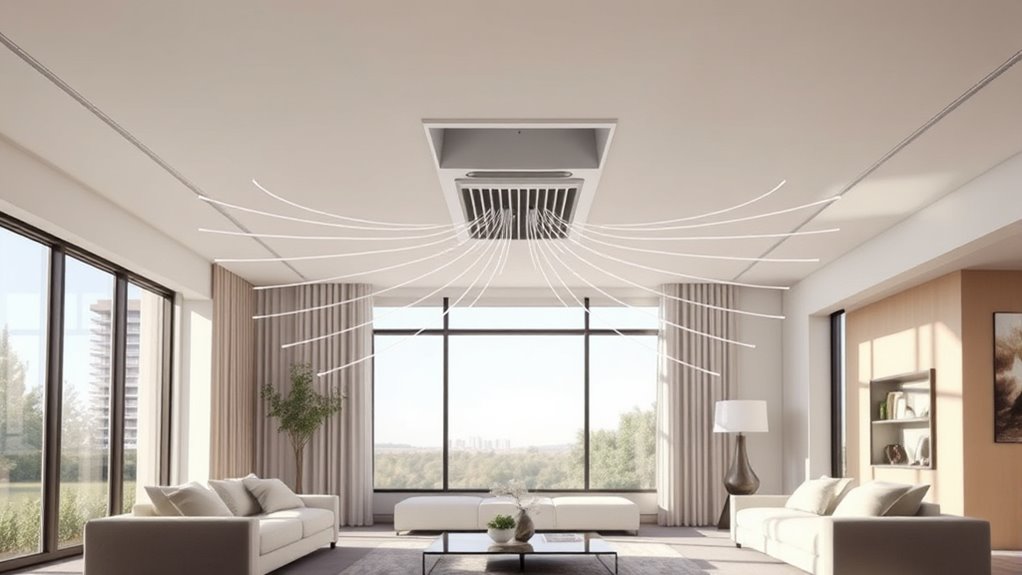
To guarantee your return jets work efficiently, start by examining your room’s size and layout to identify open areas and potential airflow paths. Look out for obstacles or furniture that might block air circulation and create dead zones. Pay attention to existing vents and how air naturally moves through the space to find the best placement for maximum airflow. Incorporating a smart circulation system can further optimize airflow distribution throughout the space.
Room Dimensions and Layout
Have you considered how your room’s dimensions and layout influence airflow when placing a return jet? Larger rooms require careful planning to guarantee air circulates evenly. If your space is long or wide, placing the return jet centrally helps distribute air more effectively. Smaller rooms might need multiple return points to prevent dead zones. The shape of your room also matters; irregular layouts can create pockets of stagnation. Keep in mind that high ceilings can cause warm air to rise, making strategic return placement vital for maintaining a consistent temperature. By understanding your room’s size and shape, you can position the return jet to promote smooth, even airflow throughout the space, reducing hot or cold spots and improving overall comfort. Additionally, maximize space and organization by creating designated zones can help optimize airflow and prevent dead zones.
Obstacle and Obstruction Zones
When positioning your return jet, it’s important to take into account obstacles and obstructions that could block or disrupt airflow. Large furniture, cabinets, or structural features like beams can create dead zones if they interfere with the jet’s placement. Items placed directly in front of or behind the return can cause air to circulate poorly, leading to uneven temperature distribution. You should identify areas where airflow might be restricted and avoid installing the jet there. Keep walkways clear, and ensure that vents are not blocked by drapes or clutter. By evaluating your space for potential obstructions, you can position your return jet where it can operate efficiently, promoting smooth circulation and eliminating dead spots. Additionally, considering room layout and furniture placement can help optimize airflow and prevent dead zones. This step is key to achieving ideal airflow throughout your room.
Airflow Patterns and Vent Placement
Evaluating your space for ideal airflow involves understanding how air moves naturally through the room. You need to identify existing flow patterns and plan vent placement accordingly. Proper placement encourages efficient circulation, reducing dead zones. Consider the direction of air currents and how furniture or walls influence movement. To help visualize, here’s a simple guide:
| Airflow Pattern | Vent Placement Strategy | Common Obstructions |
|---|---|---|
| Circular flow | Position vents opposite each other | Large furniture |
| Corner drafts | Use return jets nearby | Pillars or partitions |
| Rising warm air | Install vents at ceiling level | Cluttered spaces |
| Cool air inflow | Place vents near entrances | Wall-mounted fixtures |
This approach guarantees your vents support natural airflow and eliminate dead zones. Additionally, understanding air circulation principles can help you optimize overall ventilation efficiency.
Techniques for Strategically Positioning Return Jets

Strategically positioning return jets is crucial for maximizing airflow and guaranteeing efficient circulation within your system. Start by identifying areas where air tends to stagnate or where dead zones form. Place return jets near these spots to draw in stale air and promote even circulation. Use multiple jets to create a balanced flow, avoiding concentrated airflow in one area. Consider the height and angle of each jet—placing them higher can help pull warm air upward, while angling them toward problem zones increases effectiveness. Keep the placement consistent with your room’s layout, avoiding obstructions that hinder airflow. Regularly assess airflow patterns and adjust jet positions as needed to maintain ideal circulation and eliminate dead zones. Proper placement ensures your system works efficiently and maintains a comfortable environment.
Common Mistakes to Avoid in Return Jet Placement

One common mistake in return jet placement is overlooking the importance of avoiding obstructions. Placing jets too close to equipment, pipes, or structural elements can disrupt airflow, creating dead zones instead of preventing them. Another mistake is positioning jets too high or too low, which can cause uneven circulation. You should also avoid placing jets directly against walls or corners, as this limits their effectiveness. Additionally, neglecting to consider the overall airflow pattern can lead to poor circulation and stagnant areas. Failing to test different placements before finalizing can result in inefficient circulation. In conclusion, ignoring the importance of balancing multiple return jets may cause uneven flow, defeating the purpose of smart circulation strategies. Always evaluate your setup carefully to optimize jet placement and airflow.
Benefits of Proper Return Jet Arrangement
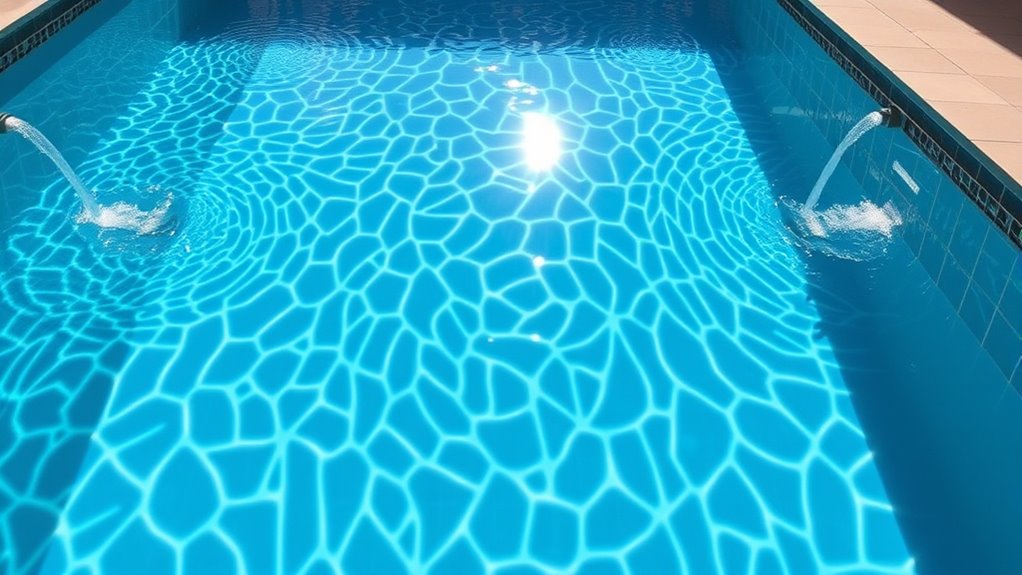
Properly arranging your return jets guarantees efficient airflow, which can substantially improve the overall ventilation performance. When your return jets are correctly positioned, they help create a balanced airflow pattern, reducing dead zones and hot spots. This setup assures that stale air is quickly removed and fresh air circulates evenly throughout the space. Proper placement also minimizes strain on your HVAC system, leading to better energy efficiency and lower utility bills. Additionally, it enhances indoor air quality by consistently removing pollutants and humidity. With the right return jet layout, you’ll experience more consistent temperatures and improved comfort. Overall, thoughtful return jet placement optimizes your ventilation system’s effectiveness, making your environment healthier, more comfortable, and more energy-efficient.
Practical Tips for Maintaining Efficient Circulation
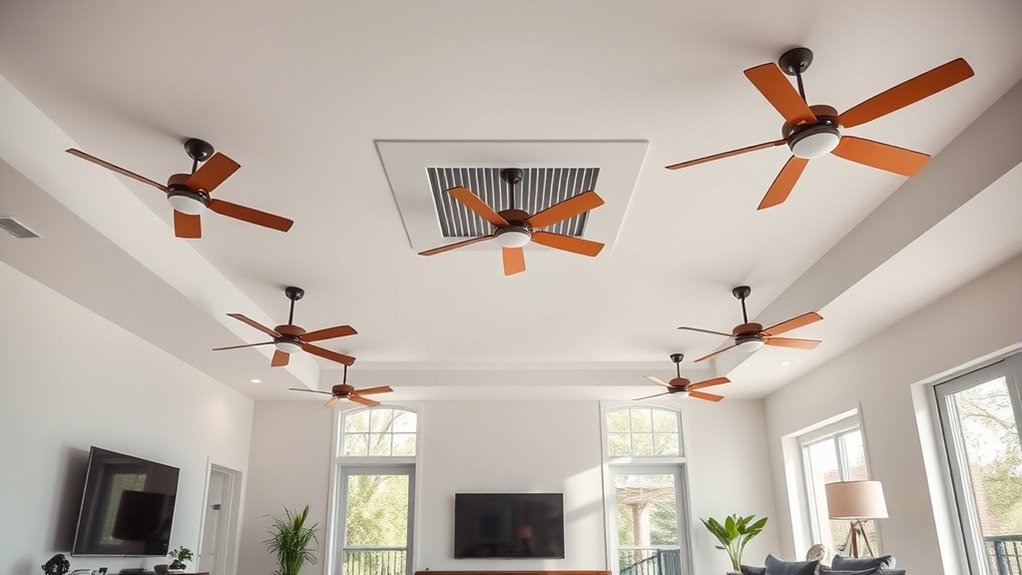
Regularly inspecting and cleaning your return jets guarantees consistent airflow and prevents blockages that can disrupt circulation. Make it a routine to check for debris, dirt, or buildup that can restrict water flow. Use a soft brush or a gentle hose spray to remove any obstructions. Ensure that jets are properly aligned and free of leaks, as misaligned or damaged jets reduce circulation efficiency. Keep an eye on water levels and maintain proper chemical balance to prevent scale buildup or algae growth around the jets. Periodic maintenance not only keeps circulation ideal but also extends the lifespan of your system. By staying proactive with these simple steps, you’ll maintain even water distribution and eliminate dead zones, ensuring your pool stays clean, clear, and inviting.
Frequently Asked Questions
How Often Should Return Jets Be Inspected for Optimal Performance?
You should inspect your return jets at least once every six months to guarantee peak performance. Regular checks help identify clogs, leaks, or misalignments that can disrupt circulation and create dead zones. Keep an eye out for unusual noise or reduced flow, and clean or adjust the jets as needed. Consistent inspections maintain efficient circulation, improve water quality, and extend the lifespan of your pool system.
Can Return Jet Placement Affect Energy Efficiency?
Absolutely, your return jet placement can revolutionize your energy bills! When positioned correctly, it guarantees perfect circulation, making your HVAC system work like a well-oiled machine. Poor placement, on the other hand, can cause dead zones and energy waste, skyrocketing your costs. By strategically placing your return jets, you maximize efficiency, save money, and create a comfortable environment that feels like a luxury hotel—every single day.
Are There Specific Materials Recommended for Return Jet Installation?
You should use corrosion-resistant materials like stainless steel or high-quality plastic for return jet installation. These materials withstand moisture exposure and prevent rust, ensuring longevity and peak performance. Avoid cheaper metals that may corrode over time, reducing efficiency and increasing maintenance costs. Select materials that are compatible with your system’s temperature and chemical conditions to maintain effective circulation and prevent dead zones. Proper material choice helps keep your system running smoothly and efficiently.
How Do Seasonal Changes Influence Return Jet Positioning Strategies?
Like a trusty compass guiding a sailor, seasonal changes considerably influence your return jet positioning. In summer, you should aim to avoid hot spots and promote cooling, while in winter, focus on recirculating warm air to prevent cold drafts. Adjust your jets accordingly, ensuring they optimize airflow for each season, much like a thermostat that adapts to temperature shifts, keeping your space comfortable year-round.
What Are Signs That Return Jets Are Not Functioning Properly?
You’ll notice uneven temperature distribution, with hot or cold spots indicating malfunctioning return jets. Increased energy bills can also signal inefficiency. If you hear unusual noises or see water leaks near the vents, the system might be compromised. Poor airflow or reduced system performance are key signs. Check for these issues promptly to prevent further damage and make certain your circulation system operates effectively.
Conclusion
Think of your space as a bustling city, where dead zones are like traffic jams. Properly placed return jets act as the city’s circulatory system, guiding airflow smoothly and ensuring every corner receives fresh energy. When you strategically position these jets, you’re crafting a well-orchestrated symphony of circulation. With mindful placement, you keep your environment vibrant and comfortable, turning chaos into harmony—an elegant dance of air that keeps your space alive and thriving.
